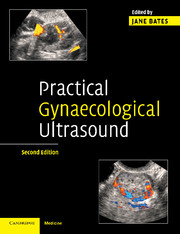Book contents
- Frontmatter
- Contents
- List of contributors
- Preface
- 1 Equipment selection and instrumentation
- 2 Practical equipment operation and technique
- 3 Anatomy, physiology and ultrasound appearances
- 4 Pathology of the uterus, cervix and vagina
- 5 Pathology of the ovaries, fallopian tubes and adnexae
- 6 Ultrasound in the acute pelvis
- 7 Ultrasound and fertility
- 8 Paediatric gynaecological ultrasound
- 9 Clinical management of patients: the gynaecologist's perspective
- Index
- References
9 - Clinical management of patients: the gynaecologist's perspective
Published online by Cambridge University Press: 04 March 2010
- Frontmatter
- Contents
- List of contributors
- Preface
- 1 Equipment selection and instrumentation
- 2 Practical equipment operation and technique
- 3 Anatomy, physiology and ultrasound appearances
- 4 Pathology of the uterus, cervix and vagina
- 5 Pathology of the ovaries, fallopian tubes and adnexae
- 6 Ultrasound in the acute pelvis
- 7 Ultrasound and fertility
- 8 Paediatric gynaecological ultrasound
- 9 Clinical management of patients: the gynaecologist's perspective
- Index
- References
Summary
Introduction
Probably the most significant contribution in the history of ultrasound within the field of obstetrics and gynaecology came from Professor Ian Donald at Glasgow in the early 1960s. The types of pathology first identified in the uterus by pelvic ultrasonic scanning included hydatidiform moles and retained products of conception. Kratochwil first described transvaginal ultrasonography in 1969, but it was only after its evaluation of infertility in the 1980s that its full potential was realised. It is now also used in the investigation and management of infertility and assisted reproduction, early pregnancy, tubal pregnancy and first-trimester pregnancy-related conditions.
Clinical use of ultrasound in gynaecology
Why do gynaecologists request ultrasound scans? As in all clinical areas, examination skills are being lost or open to marked interobserver variation, resulting in greater reliance on investigations as a substitute. This opens up the abuse of such investigations with requests made with little thought as to how the investigation will help in diagnosis or management. Ultrasound should in no way replace physical examination; it should assist in building the clinical picture to contribute to appropriate patient management.
There are occasions, nevertheless, where the bimanual examination is just not enough. Obesity makes it more difficult to feel pelvic organs, and in such circumstances a transvaginal scan makes the pelvic organs more accessible. The patient may be virgo intacta and so pelvic examination is obviously inappropriate, or in a postmenopausal woman with atrophic tissues, examination may be very difficult or sometimes impossible due to discomfort.
- Type
- Chapter
- Information
- Practical Gynaecological Ultrasound , pp. 142 - 156Publisher: Cambridge University PressPrint publication year: 2006



